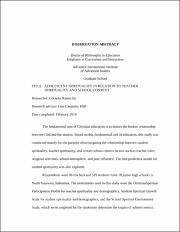| dc.description.abstract | The fundamental aim of Christian education is to restore the broken relationship
between God and the student. Based on this fundamental aim of education, this study was
conducted mainly for the purpose ofinvestigating the relationship between student
spirituality, teacher spirituality, and certain school context factors such as teacher roles,
religious activities, school atmosphere, and peer influence. The best predictive model for
student spirituality was also explored.
Respondents were 88 teachers and 519 students from 10 junior high schools in
North Sulawesi, Indonesia. The instruments used in this study were the ChristianSpiritual
Participation Profile for teacher spirituality and demographics, Student Spiritual Growth
Scale for student spirituality and demographics, and the School Spiritual Environment
Scale, which werecompleted by the studentsto determine the impact of school context.
Results showed that both teachers and students were high in their spirituality.
Teacher spirituality had a significant but weak correlation with their pastoral role(r = .13)
and religious activities (r = .16) in school. This showed that teachers who perform a
pastoral role and who perceive religious activities more positively tend to have higher
levels of spirituality. Student spirituality, on the other hand, significantly correlated with
all school context factors—teachers’ professional role (r = .51), parental role (r = .32),
and pastoral role (r = .50); religious activities (r = .27); school atmosphere (r = .45); and
peer influence (r = .33). It did not, however, correlate with teacher spirituality.
Further analysis showed that 5 of the variables studied were best predictors of
student spirituality. These were, namely, teachers’ professional role (β = 0.257), teachers’
pastoral role (β = 0.251), peer influence (β = 0.172), school atmosphere (β = 0.170), and
religious activities (β = 0.112). These variables accounted for 41% of the variance in the
extent of spirituality among the student respondents. The results indicate that student
spirituality is influenced by what they see in their teachers and what they experience in
school, but not directly by the self-assessed level of spirituality of their teachers. This
suggests that teacherscan have greater spiritual impact on students by teaching well and
by nurturing students’ spiritual life through prayer. The social nature of relationships
among peers, staff, teachers, and administrators had a stronger influence on student
spirituality than the more direct influence of religious activities. It is recommended that
further qualitative and/or mixed studies be conductedto investigatethe relationship of
teachers’ parental role to student spirituality. More areas of school life may also be
explored to determine their impact on student spirituality. | en_US |

